Fabia subquadrata (Dana, 1851)Common name(s): Grooved mussel crab, mussel crab, pea crab, parasitic pea crab, clam crab |
|
| Synonyms:Raphnotus subquadrata, Pinnotheres concharum, Cryptophyrs concharum, misspelled as Faba subquadrata | 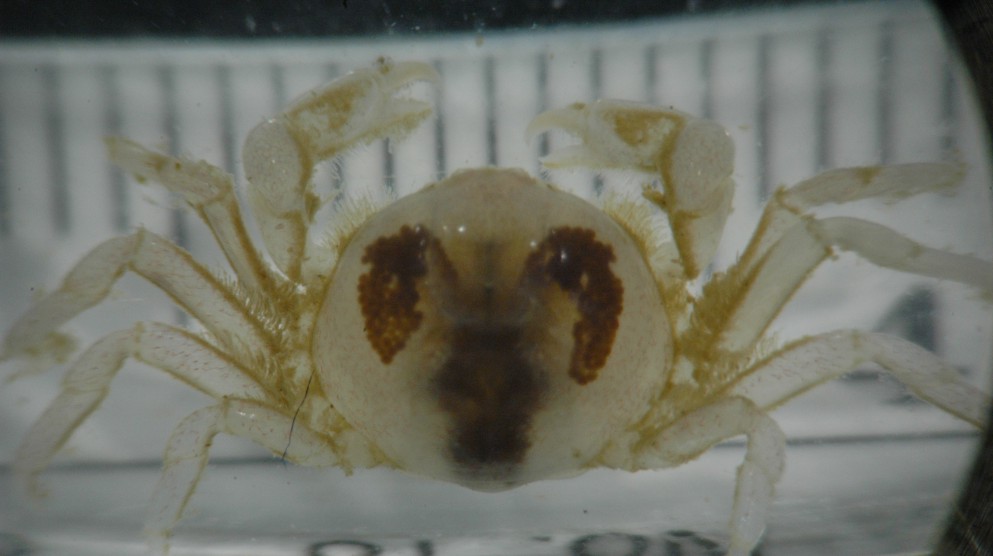 |
|
|
|
| Fabia subquadrata, a small gravid female, dorsal view. Scale in background is millimeters. The brown globules are eggs, most of which are tin the abdomen and create the dark stripe, but some are elsewhere and can be seen readily through the exoskeleton. This is a soft stage. See notes on the advantage of this below (Hines, 1992) | |
| (Photo by: Dave Cowles, May 2009). This individual was found in the mantle chamber of a Nuttallia obscurata clam purchased from a local supermarket in May, 2009. | |
How to Distinguish from Similar Species: Pinnotheres spp. have a soft carapace, nearly straight dactyls, and no dorsal longitudinal groove behind each eye. The setae on legs 3 and 4 of Scleroplax granulata are not longer than those on the other legs, plus it lives in the burrows of Thalassinideans such as Neotrypaea andUpogebia. Most other Pinnotherids have a carapace more than 1.5x as wide as it is long. F. concharum, the smooth mussel crab which lives in California, does not have the dorsal longitudinal grooves in the carapace.
Geographical Range: Akutan Pass, Alaska to Ensenada, Baja California, Mexico
Depth Range: Intertidal to 220 m
Habitat: Planktonic, or lives commensally or parasitically within bivalves such as Modiolus modiolus, Mytilus californianus, Tresus capax, Mytilus trossulus, Mya arenaria, Astarte compacta, Cardita ventricosa, Crenella columbia, Nuttallia obscurata (not reported in the literature but that is where I have found it several times), or in Kellia spp.
Biology/Natural History: This species lives within bivalves. Unlike some other pea crabs, only one individual is found within the host (e.g., not usually a male-female pair). Juveniles settle from the plankton and enter a bivalve host where they remain soft. After 7 or more molts they molt to adults, which have hardened integument. The adults swim again through the plankton, where females are fertilized in the early summer. Males apparently die soon afterward (a few may re-enter a mussel), but females enter new mussel hosts, molt 5 more times to the soft stage seen here, lay eggs, and fertilize them from her store of sperm. Mating takes place in late May in Puget Sound. It takes the female about 21-26 weeks from the time she re-enters a mussel until she produces her eggs. Eggs are found in November in Puget Sound (but note the May date for the individual above and mid-April for the second individual shown below).
The gravid females damage the clam's gills plus take food from the clam so they should probably be considered parasitic rather than commensal.
The most common host for this species in the Puget Sound area is Modiolus modiolus. Off California the crab is found in 1 to 3% of the mussels (Ricketts et al., 1985) or up to 80% according to Hinton, 1987, and in 18% of the Modiolus population off Vancouver Island. Ricketts et al. state that mature crabs are found only in mussels, which was disproven by these individuals. Ricketts et al. also report that at San Juan Island they could not be found in Mytilus mussels, though Hinton states that they are the favored host in California. O'Clair and O'Clair state that Modiolus capax is the preferred host in Alaska.
Since gravid females are so much larger than males and are soft, they were originally described as a separate species. In most Brachyuran crabs the total egg mass that females can carry is only about 10% of their body mass, but in Pinnotherid crabs such as Fabia subquadrata, females can carry an egg mass up to 97% of their body mass because their ovaries, which are confined to the thorax in most crabs, also extend into the abdomen in this species. The soft, lightly-calcified exoskeleton also allows their body to stretch to make more room for eggs (Hines, 1992).
While tlarge majority and abundant species of true (Brachyuran) crabs walk sideways, in a 2025 preprint, Taniguchi et al. found that at least some Pinnotherid crabs (genus Arcotheres) walk forward. They speculate that the sideways walking in so many true crab species is is because walking sideways allows for rapid escape locomotion options in two directions, providing a selective advantage. Adult Pinnotherids, on the other hand, such as this species, typically live as symbionts in other invertebrates and may not need a rapid escape response.
| Return to: | |||
| Main Page | Alphabetic Index | Systematic Index | Glossary |
References:
Dichotomous Keys:Carlton, 2007
Coffin, 1952
Flora and Fairbanks, 1966
Kozloff 1987, 1996
Wicksten, 2009
General References:
Hart,
1982
Hinton,
1987
Jensen,
1995
Kozloff,
1993
Lamb
and Hanby, 2005
Morris
et al., 1980
O'Clair
and O'Clair, 1998
Ricketts
et al., 1985
Scientific Articles:
Burnett, Nicole, 2024: A practical identification guide to the zoeae of the invasive European green crab, Carcinus maenas (Linnaeus, 1758) (Decapoda: Brachyura: Carcinidae), and to the zoeae of the families of brachyuran crabs in Washington state, USA. Journal of Crustacean Biology 44:4. doi.org/10.1093/jcbiol/ruae064
Hines, Anson H., 1992. Constraint on reproductive output in Brachyuran crabs: Pinnotherids test the rule. American Zoologist 32: pp. 503-511
Irvine, Alfred John, 1960. Laboratory culture methods and larval stages of Fabia subquadrata (Dana). Master's Thesis, Walla Walla College. 52 pp
Pearce, J.B., 1966. The biology of the mussel crab, Fabia subquadrata, from the waters of San Juan Archipelago, Washington. Pacific Science 20:1 pp. 3-35
Taniguchi, Cunya, Tsubasa Inoue, Kano Kohara, Jung-Fu Huang, Atsushi Hirai, Nobuaki Mizumoto, Fumio Takeshita, and Yuuki Kawabata, 2025. Evolution of Sideways locomotion in crabs (Preprint). doi:
Web sites:
General Notes and Observations: Locations,
abundances, unusual behaviors:
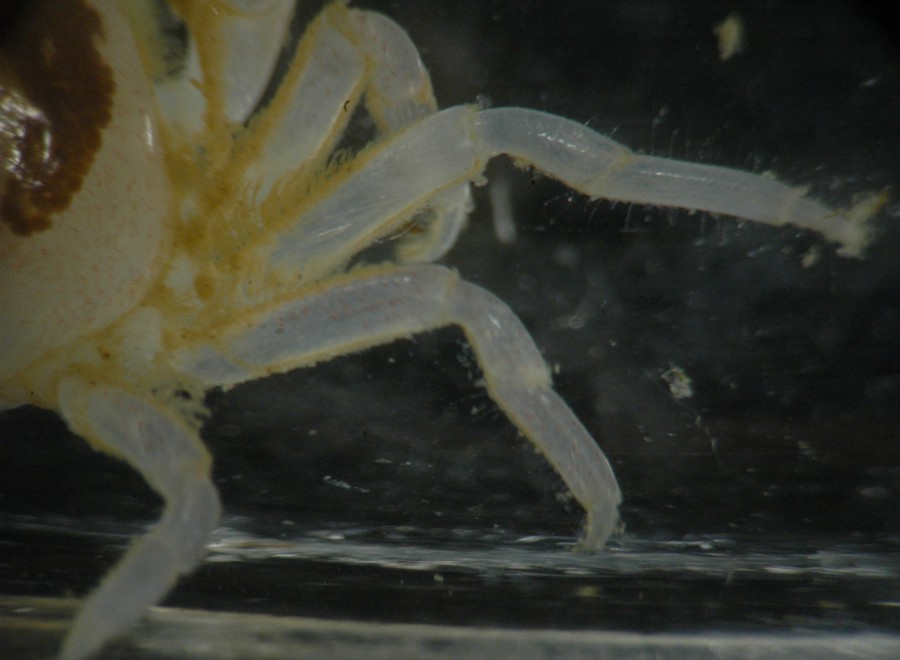
The dactyls
are strongly curved. Setae
on legs 3 and 4, especially on the dorsal
edge of the merus,
are long and featherlike. According to Hart (1982), the legs of gravid
females have few setae
while males and non-gravid
females have many more setae
(which may be used for swimming), plus hard carapaces.
Hard individuals (mature males and non-gravid
females) have more opaque carapaces,
flatter legs, more long setae
on the legs, and red articulations on the carapace.
This individual seems intermediate between these conditions.
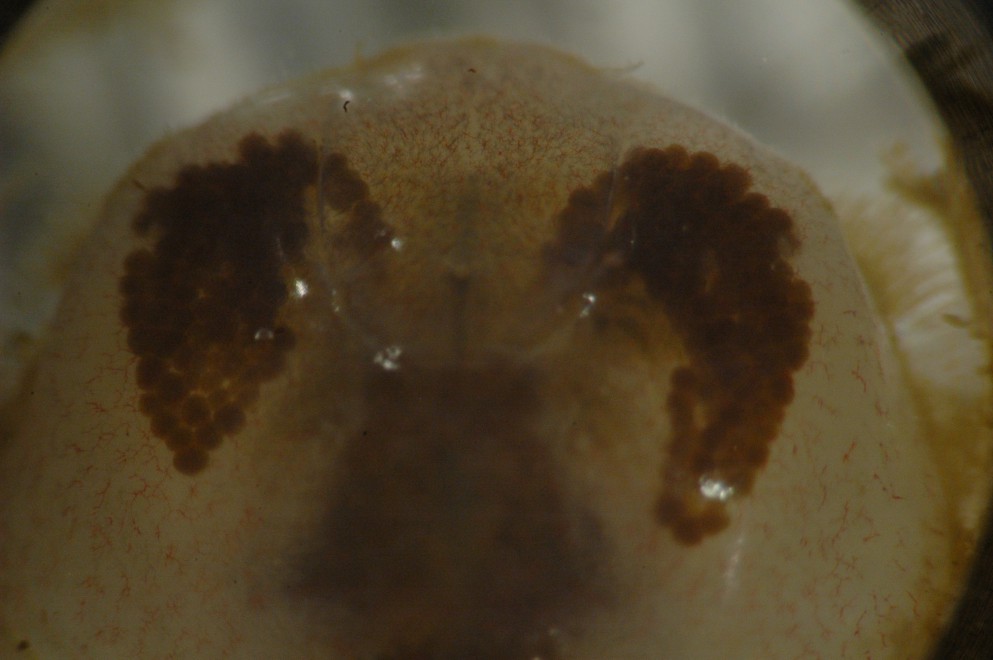
This closeup dorsal
view of the carapace
shows the egg clusters in the gill chamber. The dorsal
longitudinal grooves extending back from the orbits
as well as the transverse
groove can also be seen.
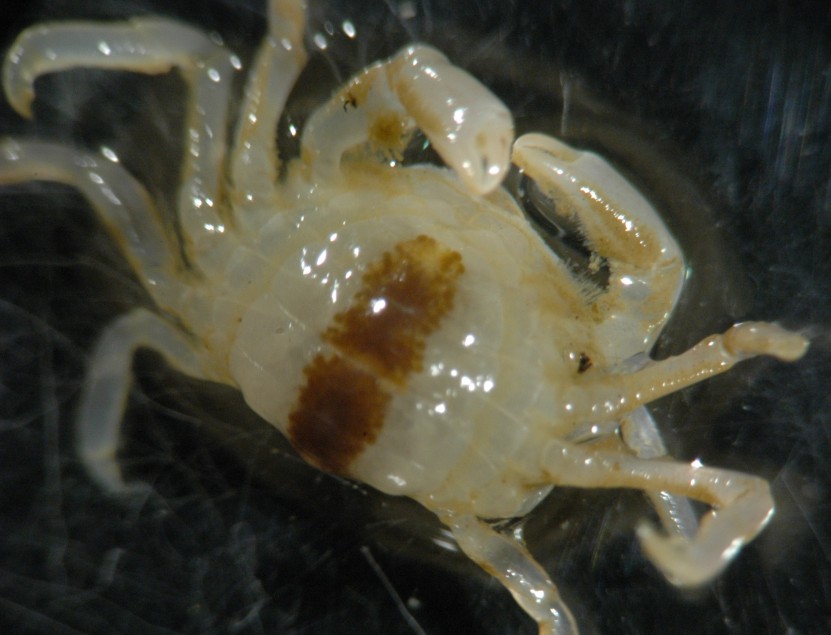
This ventral
view shows the larger cluster of eggs carried on the abdomen, as is normal
for Brachyuran crabs (and other members of Suborder Pleocyemata).
I have not heard reports of other brachyuran crabs which have some of their
eggs up in the gill chambers, as this individual does. Also, several
references state that in gravid
females the abdomen is wider than the carapace,
but that is not true of this individual. Johnson and Snook (1955)
state that the propodus has two rows of setae
on the ventral side. The outer row extends to the base of the fixed
finger while the inner row extends to the tip. Those rows can be
seen here.
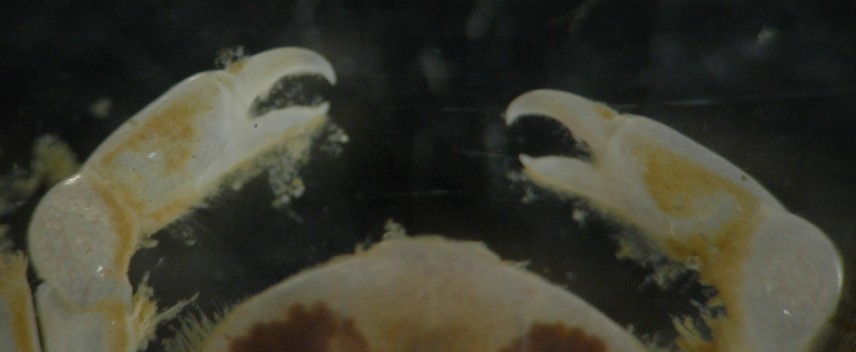
This dorsal view shows the chelae. The tips of the chelae can
cross.
Here is a second live, gravid female, found in a live Nuttalia obscurata clam from the local Walla Walla supermarket on April 17, 2017. Carapace is 10 mm wide.
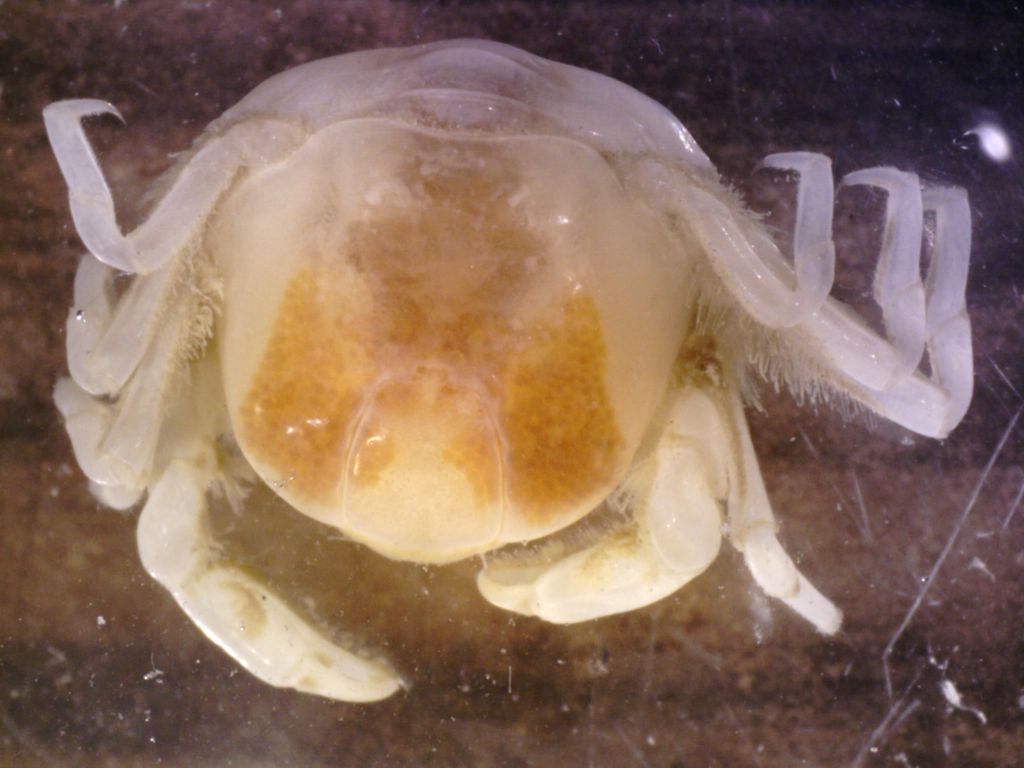
Note the easily-seen eggs through the dorsalcarapace,
on both sides but medial
to most of the gill chamber. Perhaps they are in the coelom or in a greatly
enlarged ovary?
Note also that the longitudinal lines extending back from each eye
and the transverse line joining them can be clearly seen. Photo by Dave
Cowles, April 2017
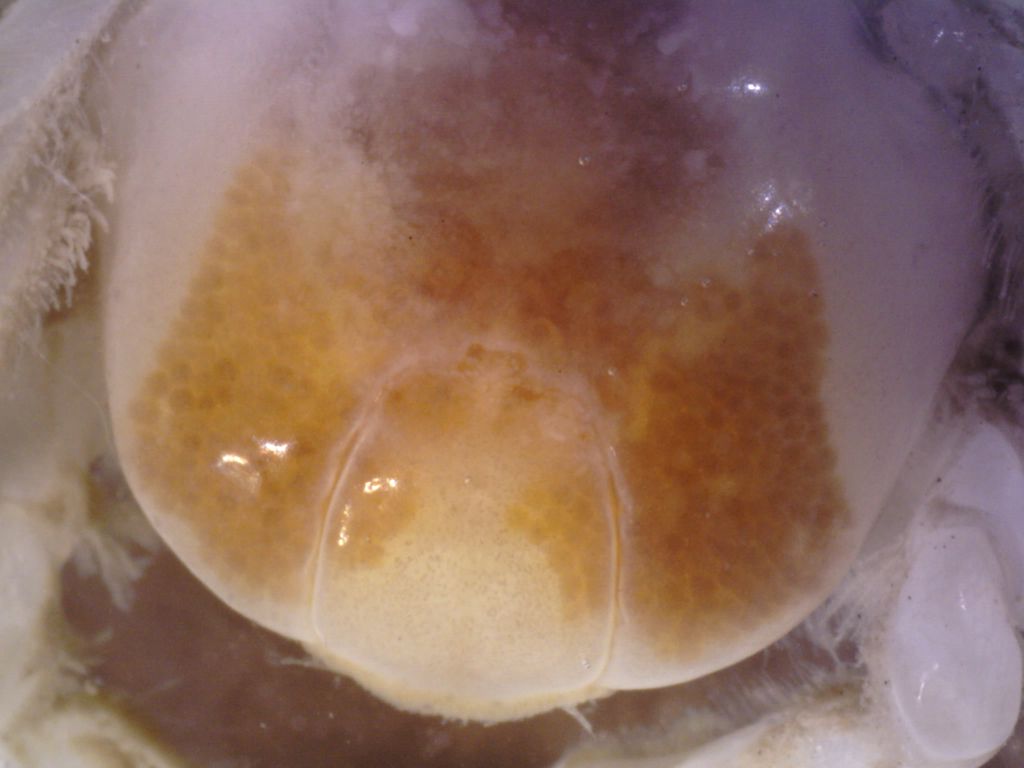
This closer view of the dorsalcarapace
clearly shows the eggs packed within the dorsal
side. Photo by Dave Cowles, April 2017
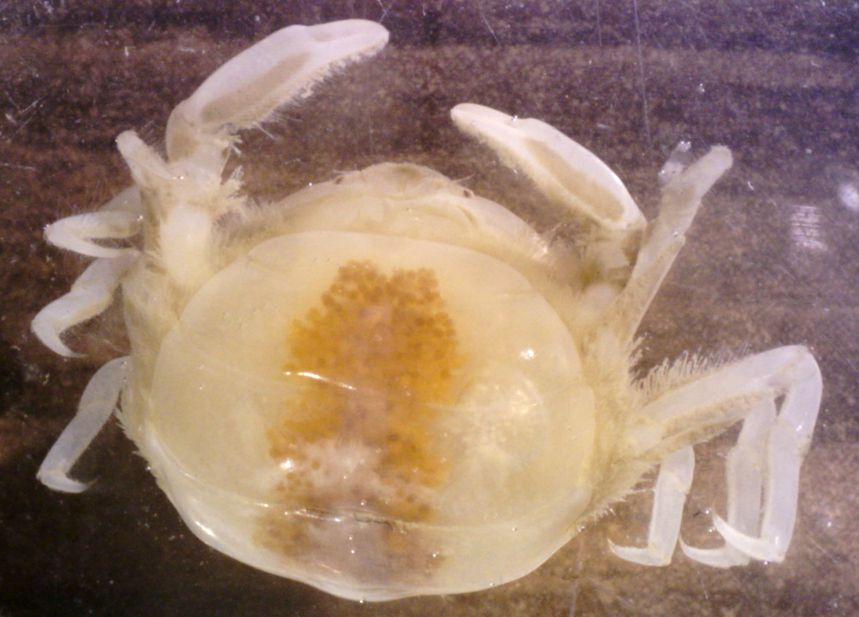
This ventral
view shows an extremely wide abdomen
(11 mm wide, so at least as wide as the carapace),
and the eggs being carried there.
Photo by Dave Cowles, April 2017
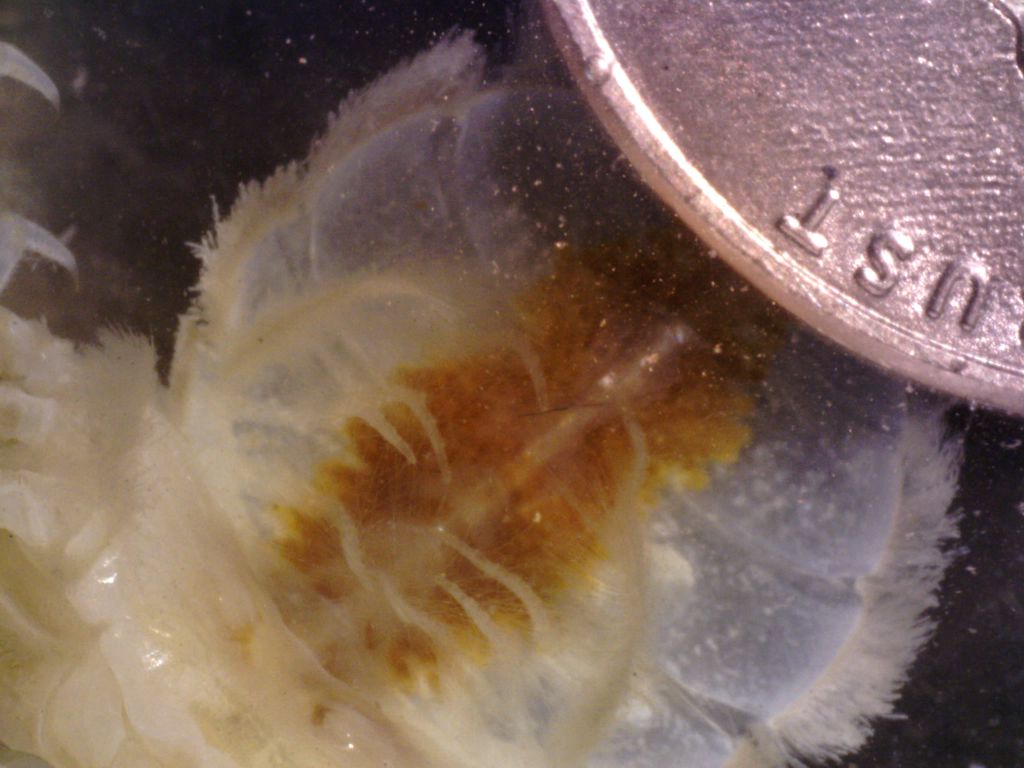
This closeup view of the abdomen
in the opened position shows the eggs attached to the pleopods,
as is standard in most decapods. However, most of the eggs are still inside
the body, as seen above. Photo by Dave Cowles, April 2017
Authors and Editors of Page:
Dave Cowles (2007): Created original page
CSS coding for page developed by Jonathan Cowles (2007)